More Beauty – less Beast | The Leica SL3
Disclaimer: This is my very first post about a camera that I don’t even own myself. This Leica SL3 and the two lenses I tested belong to Foto Görlitz, probably one of the best-known authorised Leica dealers in Germany. The owner of the shop, Alex Görlitz, kindly provided me with the equipment for testing. And not just for a few days, but for several weeks! Many thanks again at this point to Alex, much appreciated!
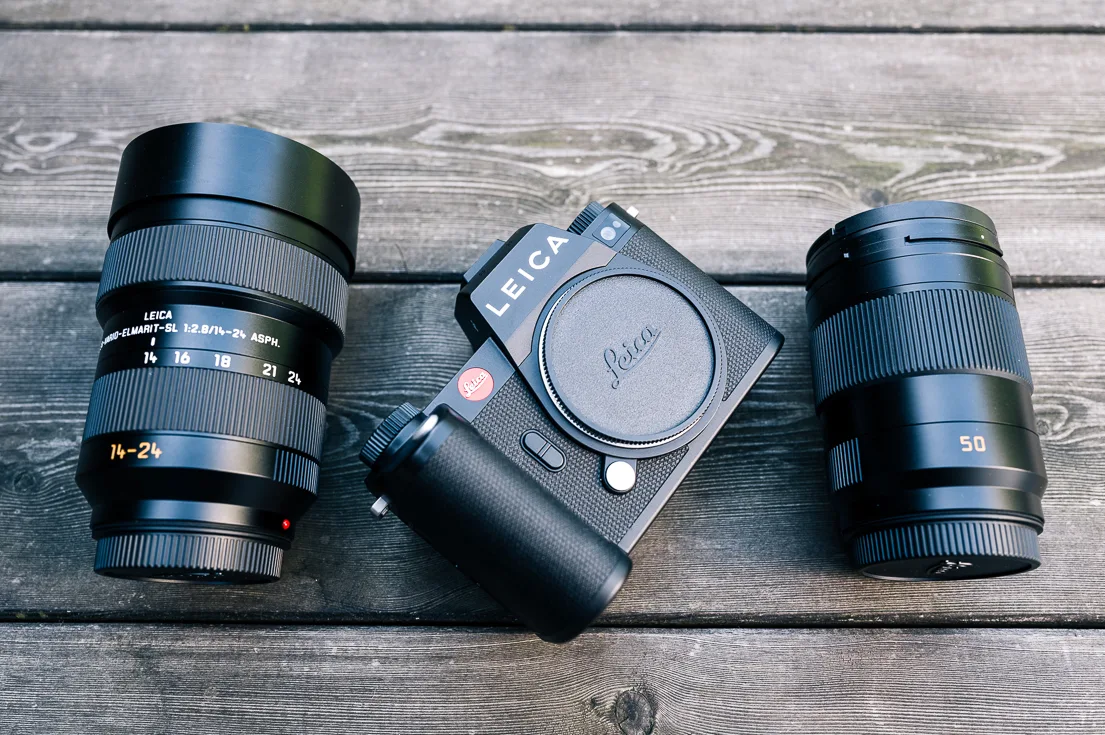
Nevertheless, I have no commercial or financial gain from this loan, no connection to the Leica company and I am only doing this out of love for photography and pure curiosity about new things. Everything I write here is my honest opinion and that will not change in the future. So, as always, independent and from a real user’s perspective. 😉
Summary
I’ll be very brief here. In my opinion, the Leica SL3 is an excellent camera with some really outstanding plus points. It provides access to exceptional lenses from both the Leica SL series and other manufacturers in the L-Mount Alliance. In terms of robustness as well as image quality – thanks to both the lenses mentioned and the fantastic sensor – nothing is left to be desired. In terms of speed and general performance, I don’t see any real weaknesses either. At least not for me.
The SL3 also scores extra points for its user-friendliness and practical ergonomics. In my opinion, there is nothing comparable out there. The user experience here is second to none. This is a very important point for me, more important than any fancy AI features.
However, in some areas (such as autofocus, AI features, global shutter, etc.), the Leica SL3 is not really at the cutting edge of technology. Of course, there are only a very few cameras anyway. If you are looking for these functions at the highest and most up-to-date level, or urgently need them for your work, then you know that yourself and might be better off looking elsewhere.
I’m not going to open up the subject of price or Leica in general here. That leads to absolutely nothing. Each and every individual has to decide for themselves, whether rationally, emotionally or economically. I also have to deal with this personally.
Shortcuts to the topics:
It’s a long and detailed review. Here you can jump directly to the points that may be of interest to you.
BUILT AND DESIGN – Body – Size and weight – Design – Coating and covering – Water and dust protection – Flip-up display – Button and wheel layout – Power button – Eyepiece and dioptre correction – TECHNOLOGY – EVF –Main display – Upper display – Sensor – Processor – Autofocus – IBIS – Menu and software – Storage – Leica Looks – FOTOS App – Battery – Video – PROS AND CONS – Thoughts about lenses – CONCLUSIONS – General thoughts – Verdict
Prologue
Well, now the guy is doing Leica reviews after all, some might say. Didn’t he first write here that he wasn’t actually going to do that? Yes, he did! So, did I lie? No, of course not! But firstly, things turn out differently and secondly as you think – as the German saying goes.
Just as I never thought I would ever shoot with Leica, I thought even less about ever reviewing a Leica SL-series camera. More on that later. But now I’ve made the decision in favour of the Leica Q3 and, lacking knowledge of the rest of the Leica system, I’ve simply become super curious. Curious about what a Leica system camera would be like – if you ever needed one.
Last but not least, I would like to make it clear that this is not a long-term use review, but more a first impression after some weeks of testing. Let’s just say that these are my initial thoughts on the Leica SL3, albeit very detailed ones.
Why an SL3?
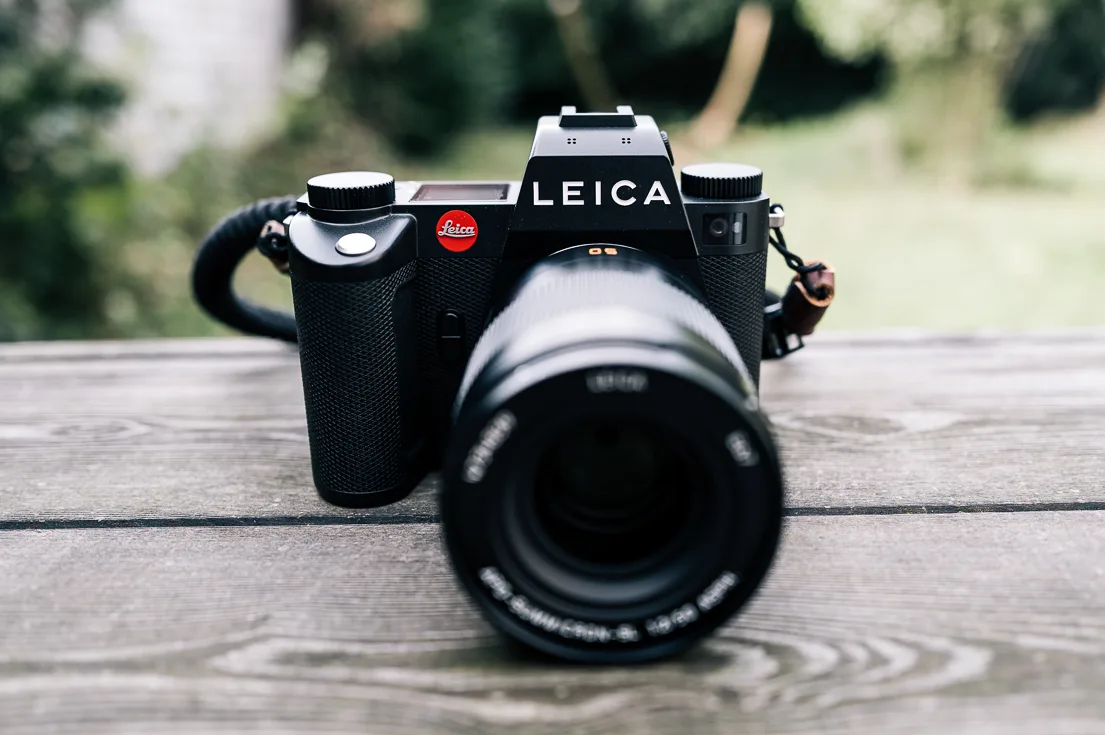
The answer is very simple. If I were interested in a system camera to complement the Q3, I would hardly have any other choice. The Leica SL series is the only mirrorless alternative in the Leica range. Under no circumstances do I want to use another system in parallel, preferably not even another sensor. That simplifies the workflow immensely. And that’s what I did with Fujifilm too.
Earlier this year, I photographed a friend’s wedding. It would certainly have worked with just a Leica Q3. Nevertheless, I gave a Fujifilm X-T5 with the new XF56mm to a friend with a good eye for portraits and similar shots. A good decision in terms of the result, but totally annoying in terms of the workflow. I had to build two new presets, and they still didn’t match 100%. Privately OK, if I were a commercial wedding photographer – no way!
Why no SL2? I like to look forwards, not backwards. Even if the SL2 is certainly still a good camera.
Body, build and design
The Body
Holy moly!
It’s not as if I’ve worked with poorly manufactured or unsturdy cameras in the past. The Fujifilms were all really high quality, as was the Olympus OM-D series. Or even my earlier Nikons, such as an FM2 or in the end my Nikon D700. All definitely robust. But this is really in a different league!




The Leica SL3 feels like a monolithic block of metal formed from a single mould. In a way it is, and that’s not meant in a negative way at all. You pick it up and think, wow, I won’t be able to break it for the rest of my life. It’s built like a tank. However, this overall impression is not only created by the very sturdy metal body. Practically everything, the dials, the display, the buttons, everything feels very robust and of high quality. With one small exception, see below…
The memory card cover is also well integrated and very sturdy. Only the covers for the interfaces are – as with many manufacturers – strange rubber flaps that somehow don’t seem really unbreakable. That’s a bit of a shame. These simply don’t fit in with the overall concept.
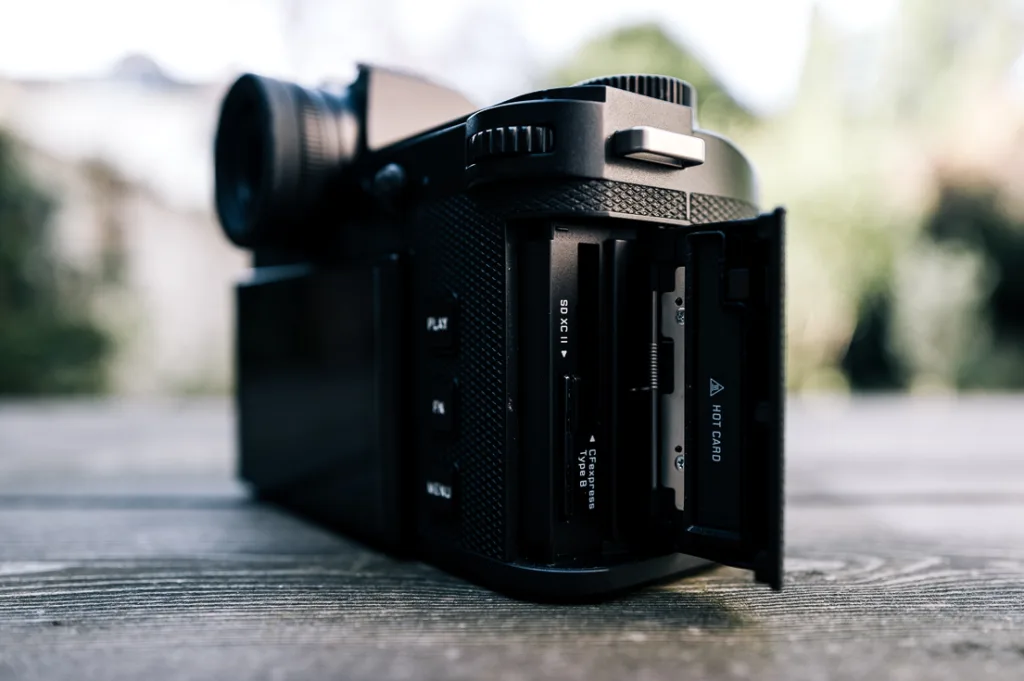
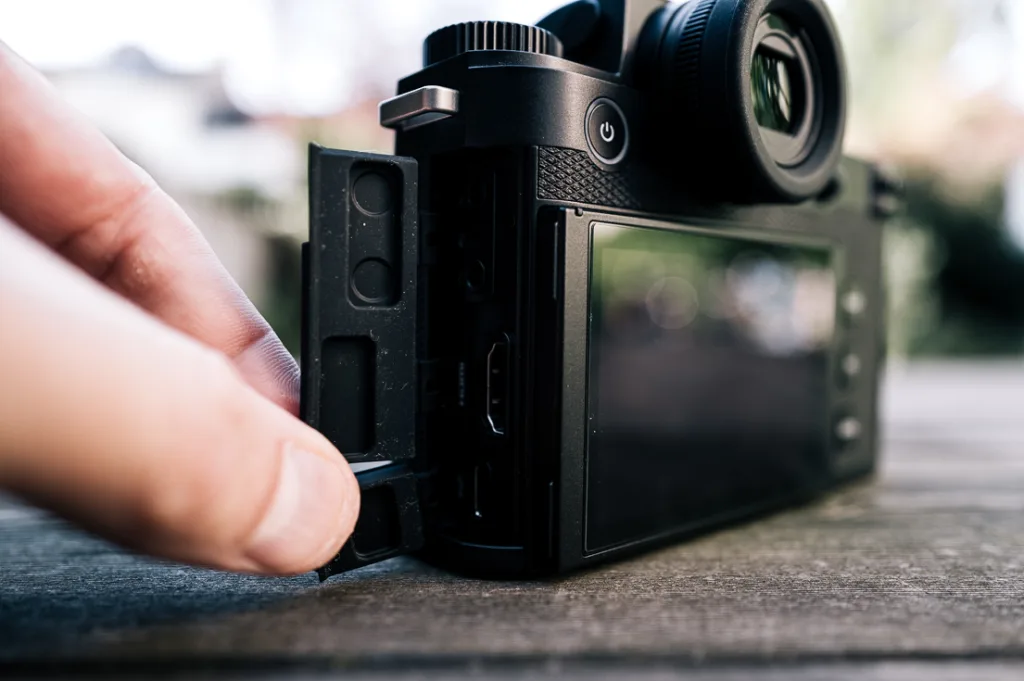
Size and weight
Of course, all this comes at a price. Weighing more than 850g (including battery and memory cards), it is not exactly one of the lightweights on the market. The weight is therefore very similar to that of a Fujifilm GFX100S.
Size-wise, I think the camera is just about OK. It’s not small, but it’s acceptable for such a professional full-frame camera. I also appreciate the fact that it is a little smaller and lighter than the SL2. But the size of the camera is only one point. For me, the size of the lenses – and therefore the overall size of the system – is much more critical.
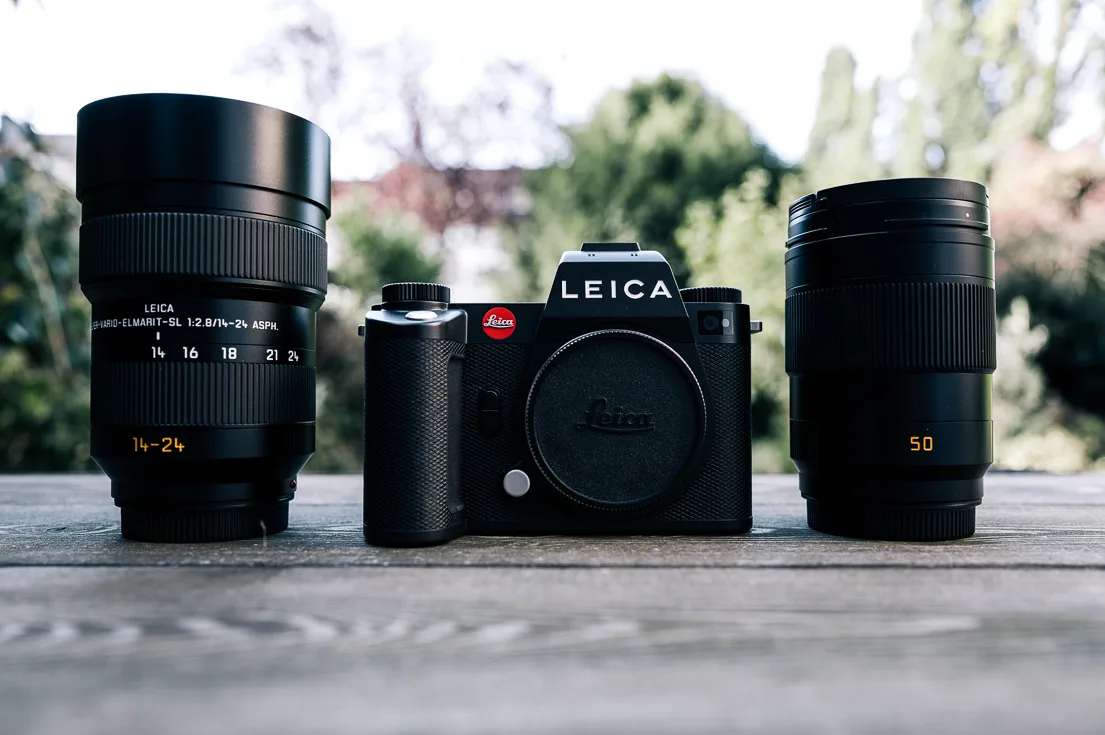
I’ll come back to that in more detail later.
The design
The Leica SL3 does not only feel valuable but is also a delight in the hands. This camera is a real beauty and like the Leica Q3 a great piece of industrial design. It’s very clean and in a good way very simple.
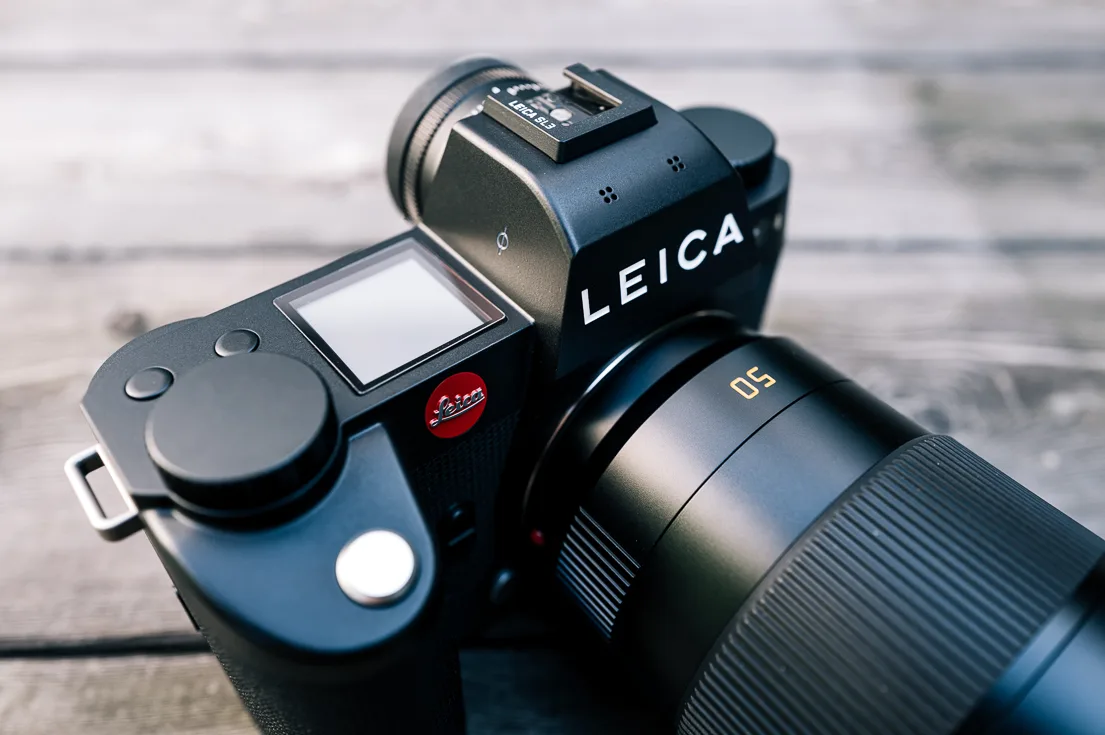
But whether the huge white LEICA lettering alongside the already conspicuous red dot was really necessary? Yes, the typeface is reasonably stylish, but it also looks a bit pretentious somehow. Leica could have dared to be a little more self-confidently understated here.
The coating and covering
The Leica comes with a rather fine and matt finish, which looks and feels very nice and seems to be very sturdy. According to Leica, the cover is made of synthetic leather. It also feels quite good, has a decent grip and honestly feels more like carbon or something.
Oh yes, and the Leica SL3 is available in any colour, as long as it’s black.
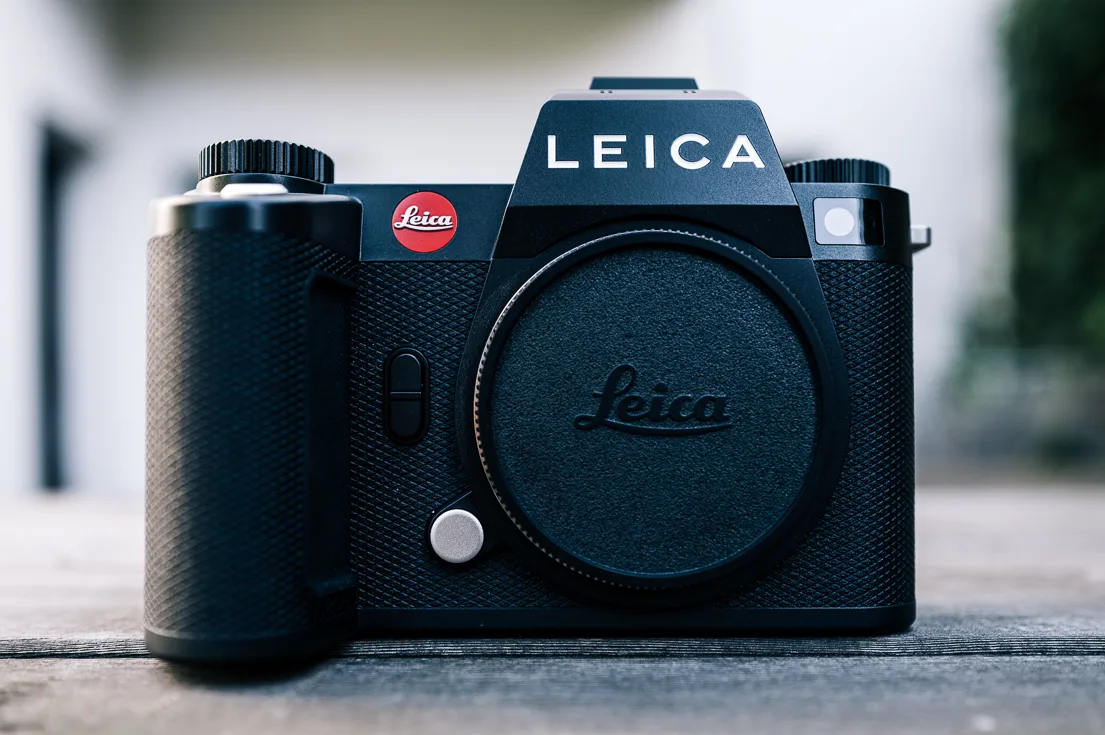
Water and dust protection
The Leica SL3 is dust and weatherproof. Leica is one of the few manufacturers to even specify the IP code (International Protection) for this. The SL3 is therefore IP54 certified. The associated explanations for this always sound somewhat technocratic. In my own words: you can even pour a glass of water over it (which I did not, Alex!). It is certainly sufficient for safe working in dusty or very rainy conditions.
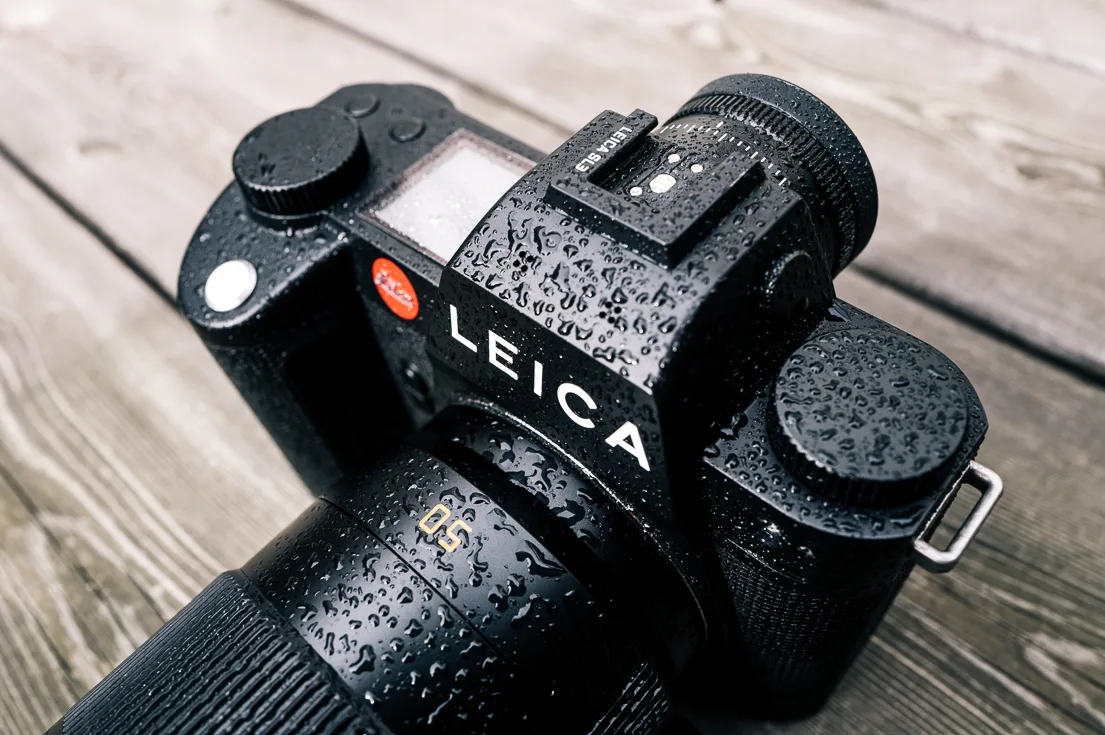
The flip-up display (mechanically)
A big step for Leica, a small step… oh no, wait. The first Leica with a flip-up display was the Leica Q3. In this respect, nothing revolutionary has happened here. Except, of course, that this type of display has now also found its way into the SL series. Fortunately, from my point of view, but I think absolute purists and aesthetes see it differently.
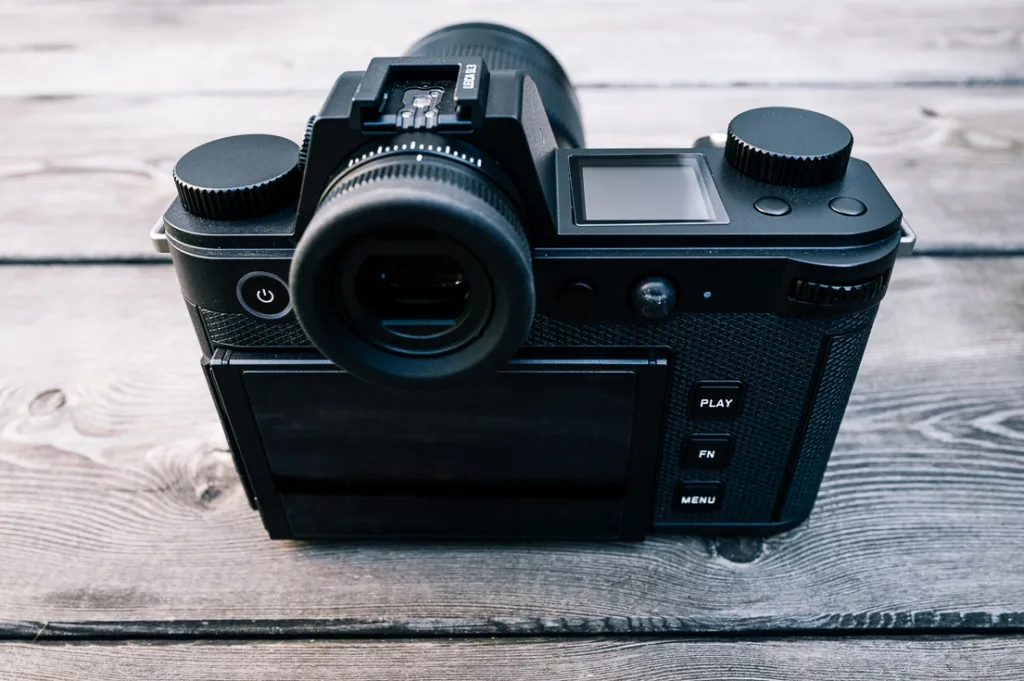
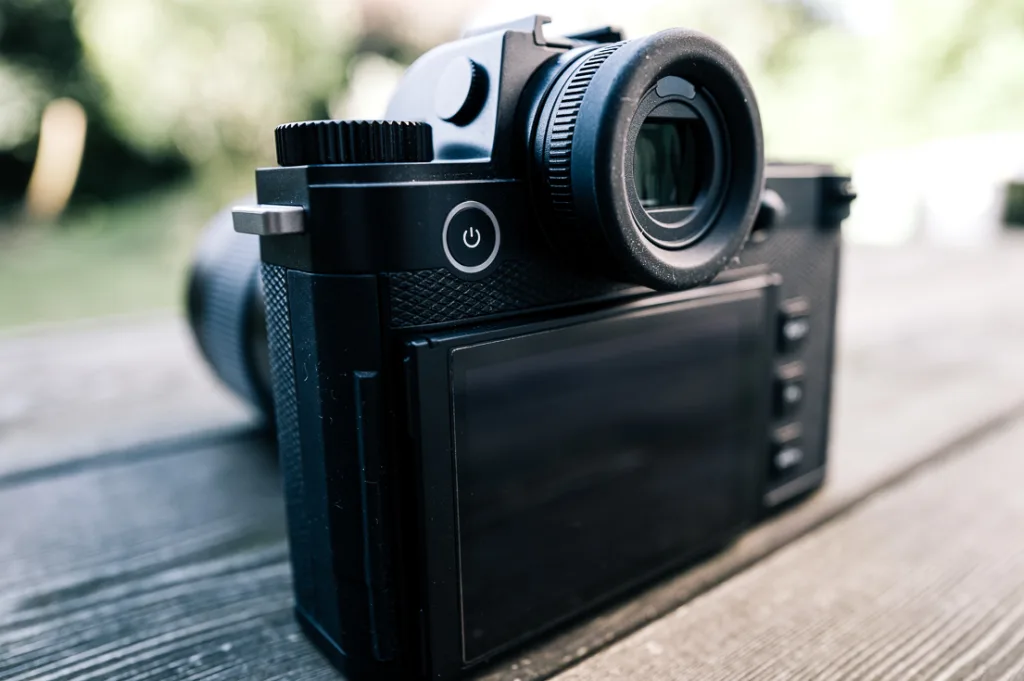
What else is there to say? It is very similar in appearance and function to the one on the Q3, but not quite identical. Above all, it is much easier to grip and fold out from below than on the Q3. There I always have to take the diversions and unfold it at the top first. All in all, it is neither the most inconspicuous (–>Fujifilm X100V/VI) nor the most flexible (–>Sony A7R V) on the market. However, it is probably the most stable one. You could hold the camera with lens only on this display – for whatever reason. That’s how sturdily it is attached.







True portrait photographers will grumble that you can’t fold it out to the side. For me, that’s OK so far.
Otherwise, as I said, apart from the unbelievable stability, the display is not a special point mechanically.
The button and wheel layout
What I like
Here comes one of the points where the Leica SL3 shines. At least for my hands and my perception, both the layout and the overall realisation are extremely well done. For me, almost all the elements are where they should be.
The buttons are large enough and tactilely very well done. The three buttons on the back in particular are really easy to operate, even when wearing gloves. And because they have been moved to the right as a result of the flip-up display, the SL3 is now easier to operate with one hand. The rear control dial is very easy to reach and can be operated very well. Putting the operating mode as a push function on this wheel was a very smart move, too.
What I particularly like, to my surprise, is the large top (right-hand) dial. It is easy to operate, smooth-running, but also resistant enough to unintentional adjustment without a lock. And it is so well positioned that I can adjust the dial – in my case the exposure compensation – practically without having to take my finger off the shutter release.
Despite the very clean-looking body, there are surprisingly many FN buttons (6 in number), so that the operation is very similar to Fujifilm in this respect. I can easily assign all the important functions directly to the FN buttons.





In two words: Excellent UX!
What I like less
Nothing, really.
With a lot of nitpicking, you could say that the two upper FN buttons are somewhat difficult to reach with the index finger – at least with the camera on the eye. But a solution to this would not be so simple. If they were placed in front of the top control dial, this would – as just mentioned – no longer be so easy to reach. So, I’m fine as it is and the two buttons are assigned to functions that I don’t need with the camera on my eye.
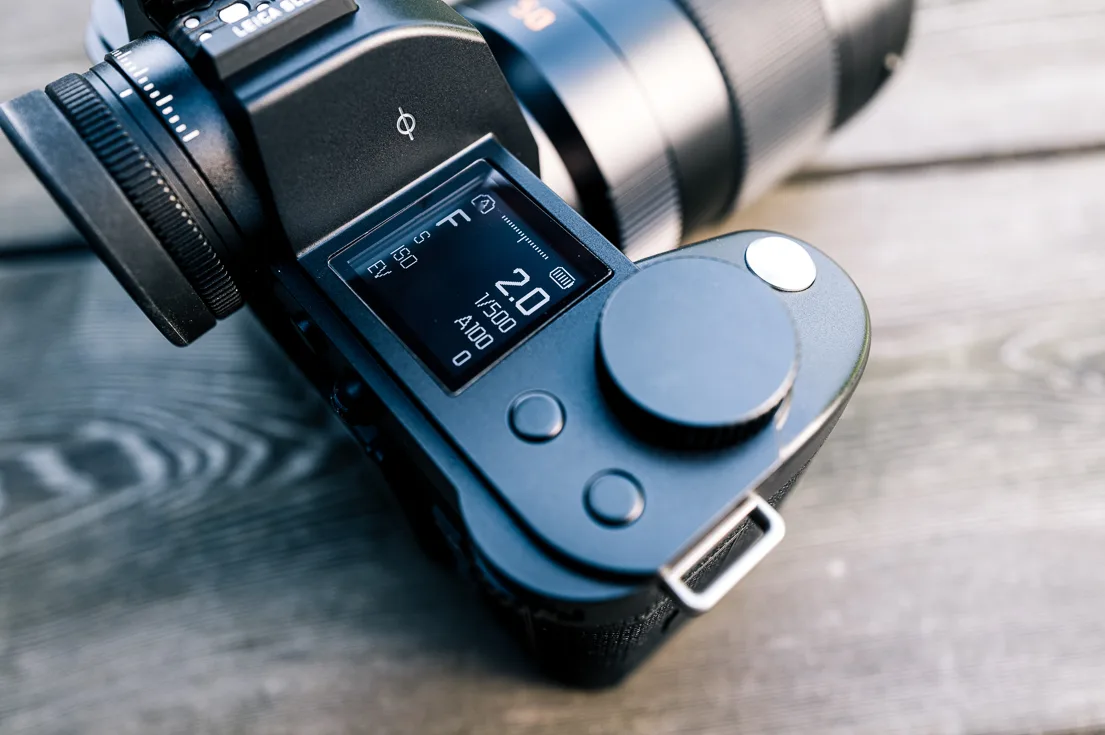
And I would have preferred to see the joystick placed a little lower, roughly above the three buttons. But you get used to it.
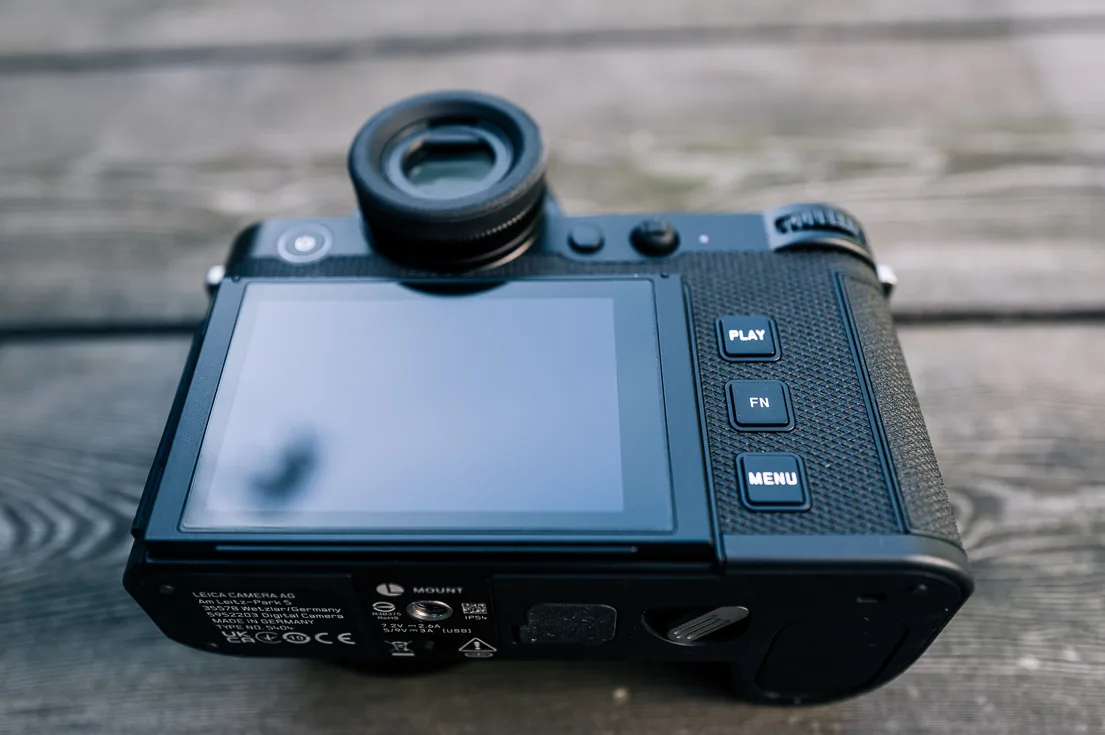
Neutral, but maybe worth mentioning
Let’s move on to a little upset in the more purist part of the Leica community: the top left-hand dial. Many consider this to be a sin of design. I don’t really think so, it fits in with the overall design. Personally, however, I wonder what I should do with it. It can be assigned to the functions aperture, exposure compensation and ISO. The first two are pointless for me on the left-hand side, the third is of no interest to me. I always use Auto ISO. So, this wheel is currently useless for me. It may be different for photographers who always set ISO manually.
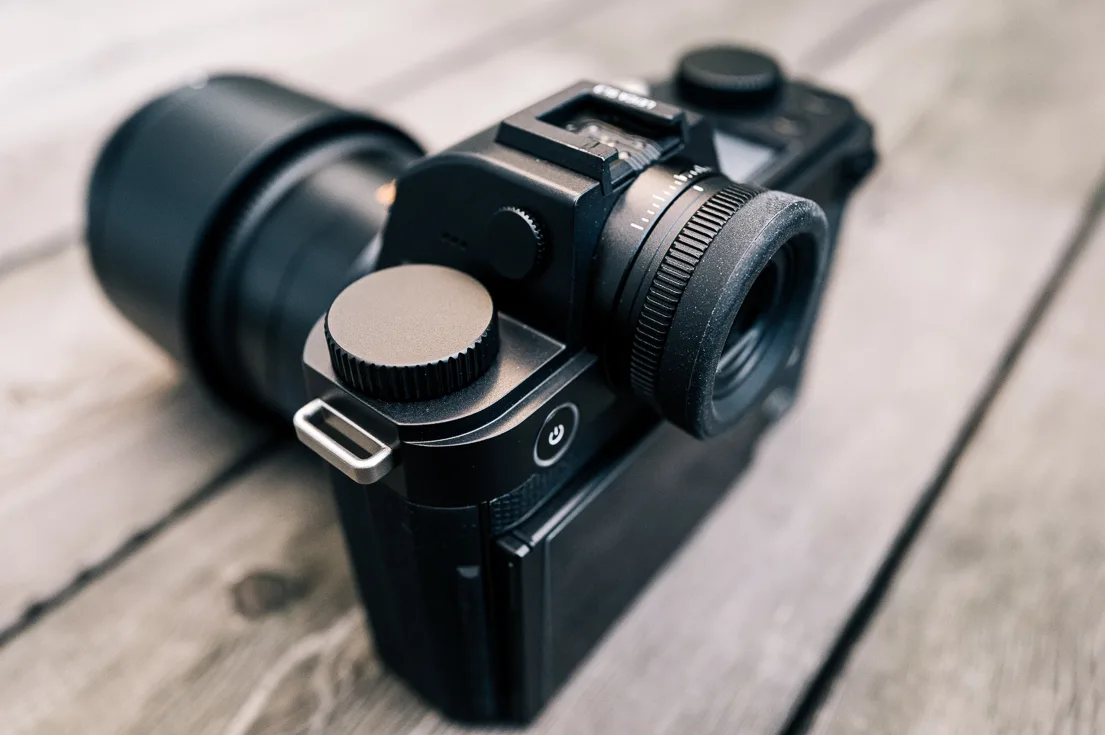
A second point of criticism is that you can’t lock it – just like the right-hand dial. This means that it could be accidentally adjusted and the ISO value changed unnoticed, for example. That’s true, but I didn’t have the impression that it could be adjusted so easily. At least not when carrying the camera. However, if you often put the camera in your photo bag, this could perhaps be a minor problem. But certainly not a showstopper. More like much ado about nothing.
I would find it useful if more functions could be assigned to this wheel in a later FW update – especially regarding the menu. A direct selection of user profiles would also be very interesting here, for example. In this respect, perhaps this dial doesn’t have to remain pointless for me in the future.
The power button
Another small controversy in the Leica community was the change of the on/off switch to a button. Until the SL2 it was a switch on the left side of the camera, but now it is an illuminated button in the same place. This now also includes a standby function. Press it and the camera goes into standby, press the shutter button and it wakes up again immediately. This is quite practical.
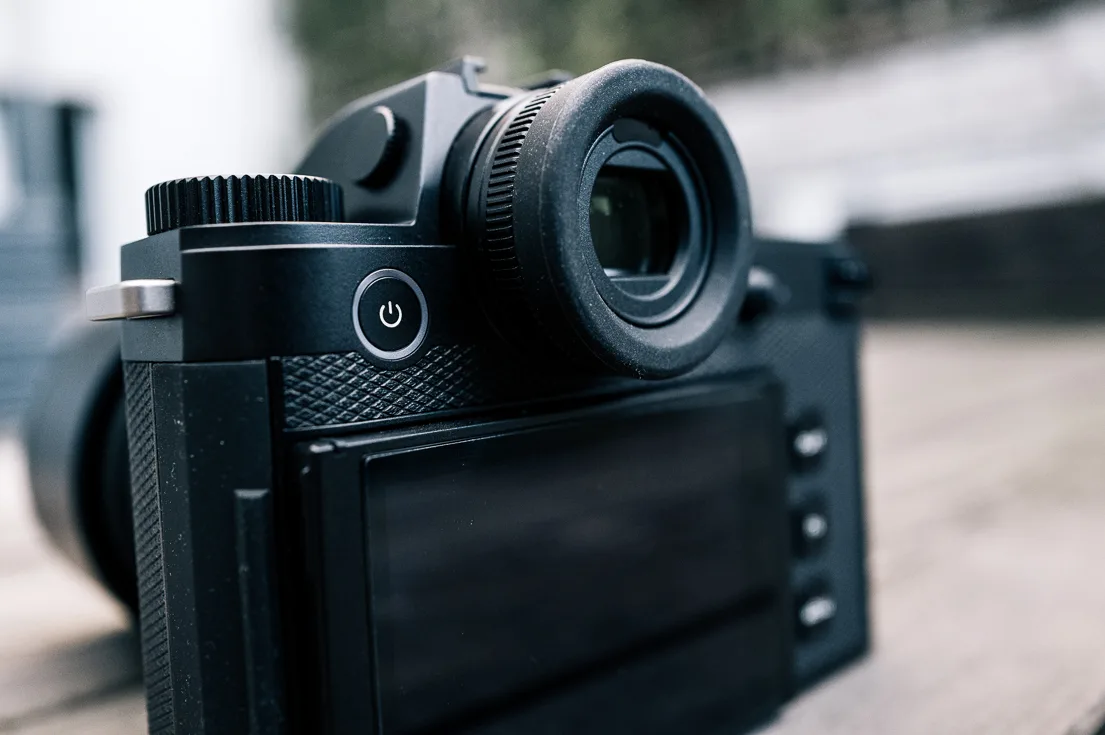
Apart from that, I don’t really understand the fuss about this thing. To be honest, I don’t find either this or the old solution super convincing. For me, a small switch directly under the shutter release, as on the Q3 and many other cameras, is the simplest and easiest solution.
The eyepiece and dioptre correction
The eyepiece is very good! Large, soft but robust and absolutely suitable for glasses. The dioptre correction is easy to use and does not accidentally change, even without a lock.
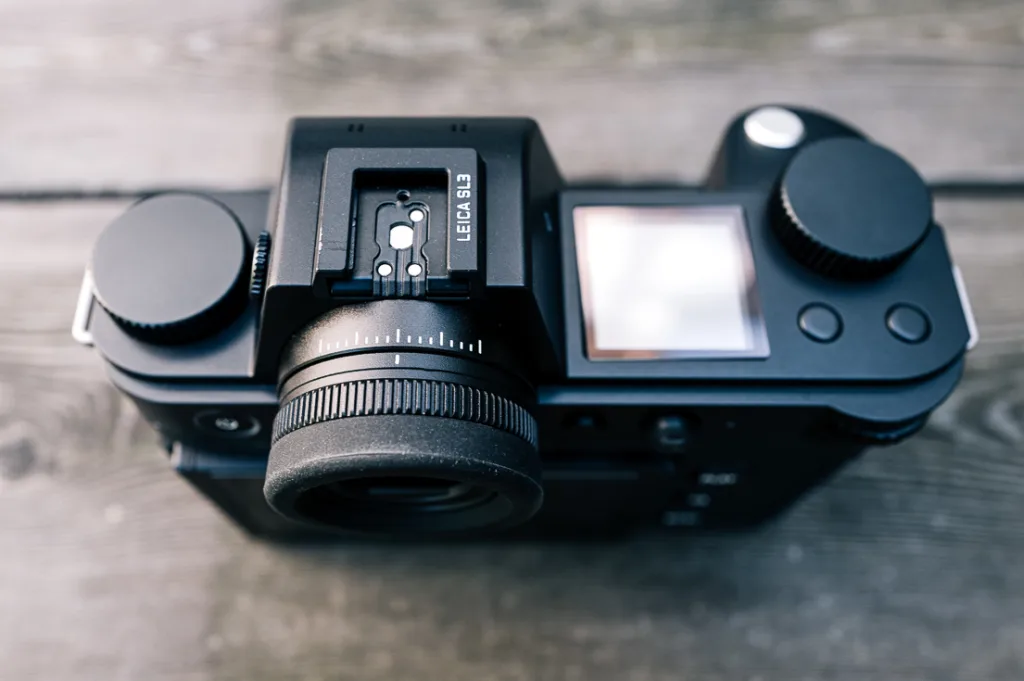
Technology
The EVF
The Leica SL3 features an electronic viewfinder with a resolution of 5.76 million pixels, a refresh rate of 60 or 120 fps and a magnification of 0.76. This means that the SL3 does not show the absolute best that is available on the market today, neither in terms of specs nor in terms of real-life impression. But this EVF is still one of the excellent ones and, in my opinion, also one of the most pleasant ones of its kind.
The only small drawback here is that when focusing, the image flickers quite visibly for a short time and looks noisy. However, this is less noticeable than with the Q3. Nevertheless, I hope that this will be significantly reduced in both cameras via a firmware update. This should not be the case with a camera in this (price) class!
The main display (electronically)
Well, what can I say? It’s good, big enough at 3.2‘’, has a good resolution at 2.32 million pixels and is – certainly the most important point – largely colour consistent with the EVF. Oh yes, and I love the fact that I can leave it completely dark – i.e. switched off – when taking pictures. Check.
The upper display
I find a display on the top of the camera very practical – especially in dark conditions. You can see the camera’s main settings immediately and get started. In this context, it’s a shame that the memory card status is not displayed. This way, you would immediately notice if you wanted to leave the house without the memory cards inserted.
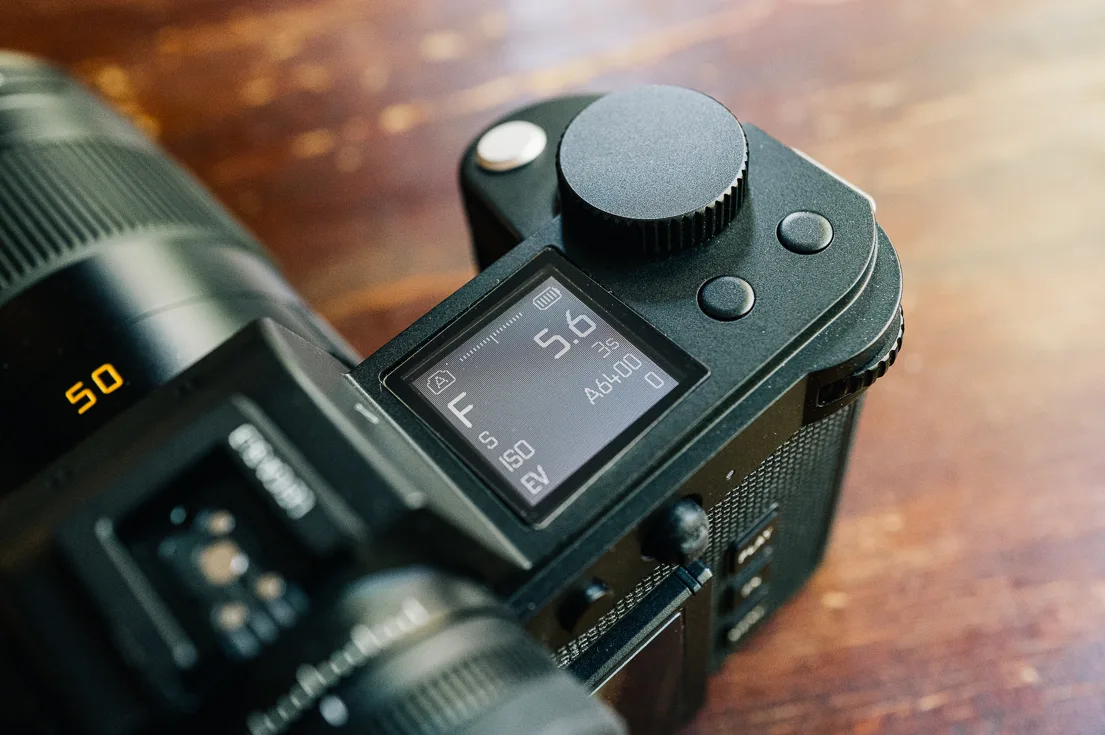
The Sensor
I have already mentioned this 60MP sensor very positively in my posts about the Leica Q3. And I still stand by this opinion with the SL3, even though the possibility of changing lenses perhaps provides slightly fewer arguments for the necessity of such a high resolution. But I think the results – in terms of sharpness, colours, dynamic range and even an amazing lack of noise at high ISOs – are fantastic. Personally, I wouldn’t want a sensor with a lower resolution in the SL3.
If 60 MP is too much for you, you can also reduce it to 36 or 18 MP with the smart implementation of the so-called Triple Resolution Technology. This also works in RAW, of course.
However, this comes at a price that will be too high for some: the rolling shutter effect. The high resolution and the conventional sensor design – neither stacked nor global shutter – result in rather slow readout times. In some video modes – but also in photos captured with the electronic shutter – the movement of the camera or the subject inevitably leads to a very noticeable rolling shutter effect. Action photographers in particular will probably give the SL3 a wide berth.

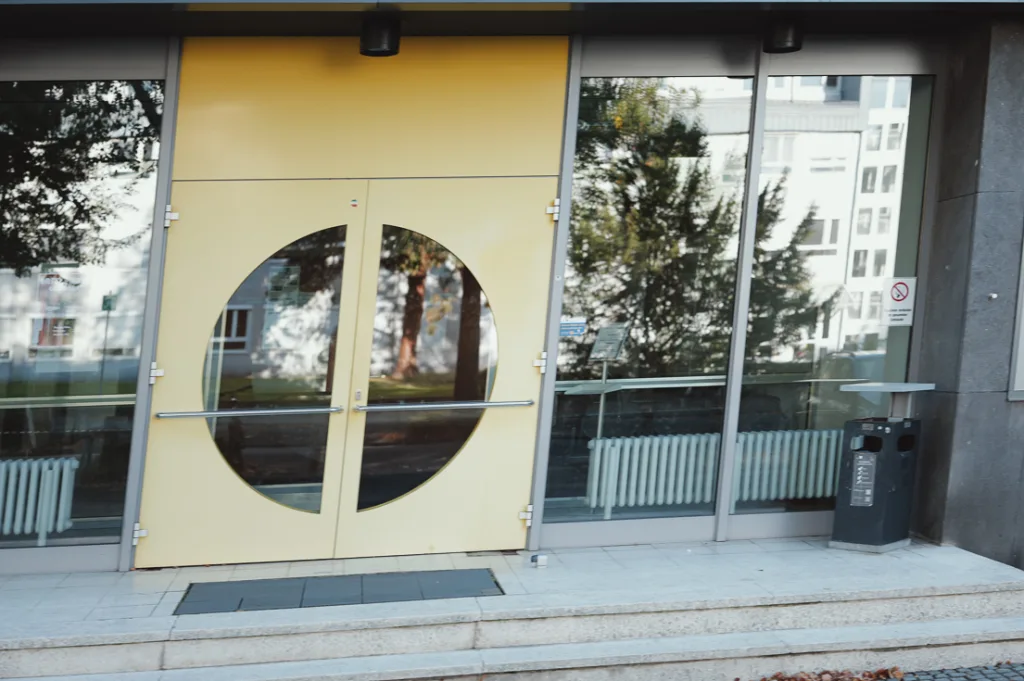
If I ever need the electronic shutter (for very fast shutter speeds), it’s only when shooting in very bright light and opening the aperture wide – for portraits, for example. In this case, the movement of the camera and subject is not really important. Anyway, it’s something you should be aware of – at least because this limits the possibilities of silent triggering.



But I have to make this clear again: this can be a problem for some people in some situations, others will never notice it. All the pictures here were taken with the electronic shutter for demonstration purposes. Of course, this would not have been necessary and so the effect would not have been there either.
And it is not a bug of the SL3, but a technical effect of high-resolution sensors of conventional design. Other cameras with this type of sensor have the same problem per se.
The processor
It is the latest Maestro IV processor from Leica. At no time and in no situation did I feel that the processor was somehow too slow. Neither when taking pictures nor when using the menu or the image viewing function.
The autofocus
This is a somewhat difficult topic. The AF-S of the SL3 (with the two lenses available to me) is OK. It’s fast enough for my type of photography, and precise anyway. I would just like the AF to be a little better in very low light conditions as well as in harsh backlight situations. There is still some room for improvement.
The situation is different when it comes to AF-C and AF tracking. Not that I have really tried this out in detail, but even when ‘playing around’ with it, you realise that these points naturally do not reach the level of the latest SoNiCanons. That is simply a fact. If you want or need that, you should definitely go to SoNiCanon.
The subject of face detection, on the other hand, is more in between. It works well and accurately enough for my needs. But I know that others want a faster and more sophisticated system.
How do I summarise it? Hm, let’s say the autofocus shouldn’t be the main purchase argument for a Leica SL3. Maybe that fits.
Oh yes, and unlike the Leica Q3, there is the option to return the AF point to the centre with a single click of a physical FN button. Thanks for that… 😉
IBIS
The IBIS is specified by Leica as having an effect of 5 f-stops. As with other manufacturers, this should at least be taken with a grain of salt. Very realistically, I would say 4 f-stops to be on the safe side. With a sensor of this high resolution, small shakes can of course be seen very quickly. In practice, I still managed very well with 1/8s exposure time with the 50mm, with limitations maybe also 1/4s. In my opinion, the IBIS is therefore somewhat better than the OIS on the Leica Q3. There I also achieve approximately these results, but with a 28mm lens. Unfortunately, I don’t have a Q3 43 at my fingertips to compare this at roughly the same focal length.
To summarise, the IBIS is very appropriate and very useful for me. So, I think the IBIS of the Leica SL3 is ‘in good company’ with most other systems.

Logically, I don’t have access to all of the very latest cameras, some of which promise an advantage of up to 8 f-stops – and I would be quite sceptical about that. That said, I cannot confirm the 7 f-stops specified for the Fujifilm X-T5, for example, despite its smaller sensor.
A small point of criticism: The IBIS is practically not configurable. Neither in terms of exposure times nor in terms of implementation – e.g. only active when taking pictures. There is essentially only an ‘on’ or ‘off’ – and a few settings for recognising panning.
Menu and software
Menu
This point is of course one where the Leica SL3 – like most Leicas – certainly shines again. The menu is clean, well-organised and not overloaded. Navigating through it is therefore also very intuitive and quick. Compared to, for example, the typeface of the Fujifilm menus, this one is a real feast for the eyes. There are no compressed letters and no crazy acronyms – and also nothing that feels like 100 menu levels. Great!
The clearly organised main menu is extremely convenient and practical – with switching between photo and video, touch functionality and quick access to all important functions. Another nice feature is that you can customise the lower menu items by holding your finger on them. This is something the Leica Q3, for example, doesn’t have. Having said that, I would have preferred 5 possible columns in the main menu of the Leica SL3 instead of 4. And I sorely miss being able to set up favourites.
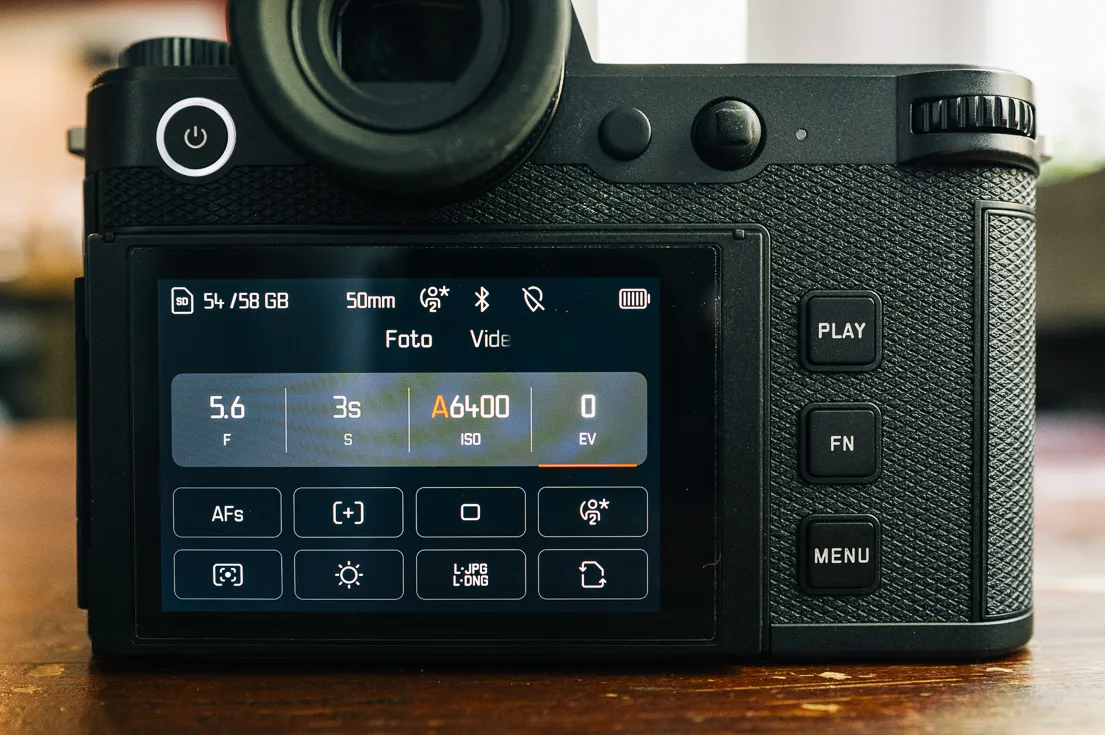
The much-discussed icons developed specially for the SL3 – the so-called Leicons 🙂 – are pretty and stylish, in my opinion. It is only with the icon for the ‘user profile’ that the designers have perhaps overshot the mark a little. It occurred to me that it was more a sign for astrophotography…
I would very much welcome if the design of the Q3 and SL3 menus were to merge. The Leicons and the improved touch functionality of the SL3, the favourites and the main menu of the Q3. That would be the optimum for me.
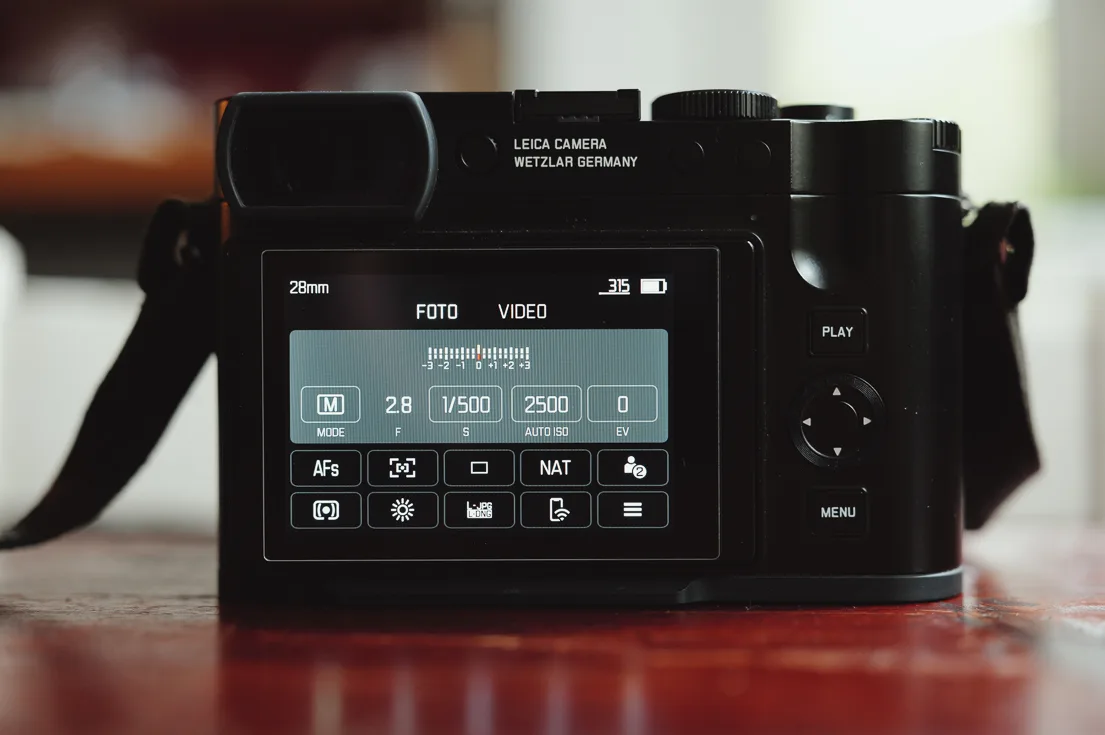
Software
Even if I have criticised the lack of a configuration options here and there, overall I am glad that the possibilities of the software have not been fully exploited. After all, the result is the undesirable huge bloating of the menu. On the whole, I think the software options are used sensibly to support the photographer.
Storage
I would have been very happy with a dual SD slot. However, I understand that the SL3 – like some newer cameras – has a very fast CFexpress card slot in addition to the SD slot, mainly for the video requirements of 8K and similar. That’s just the way it is, and so far, I’m OK with it.
But to be honest, I would have found a fast and sufficiently large internal memory next to an SD slot even cooler.
Leica Looks
I don’t want to repeat myself here, so see my comments in the posts on the Q3. In short: quite nice, but for various reasons far from what Fujifilm achieves with its film simulations.
However, there is hope for the future. Especially since a new look called ‘Chrome’ was introduced with the release of the brand-new Leica Q3 43. And this looks very useful and good to me.
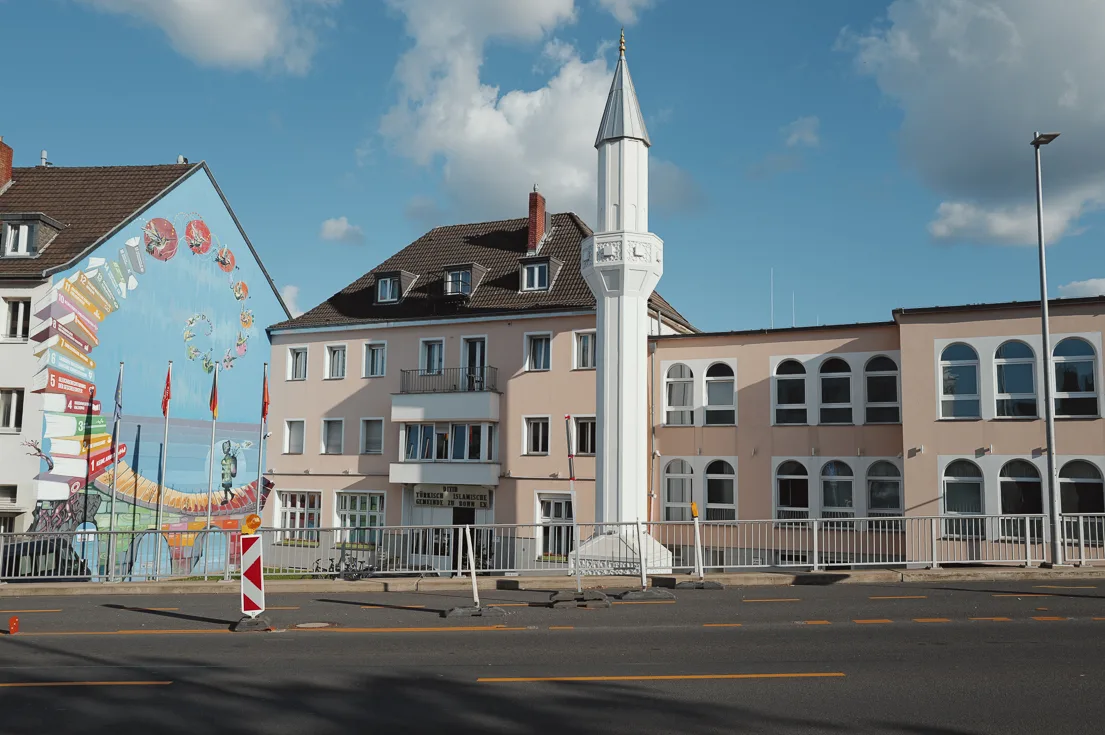
The Leica FOTOS App
The Leica FOTOS App is still the best app of its kind that I know of. It is reliable, intuitive to use and, above all, fast. Downloading images from at least the latest cameras is really super fast. You can also use it to update the firmware, load (or delete) the Leica Looks and use it as a remote control. All in all, a very good implementation!
The battery (life)
Well… the battery life is OK, but it’s not one of the SL3’s strengths. Even with the Wi-Fi turned off or set to ECO (for the Leica FOTOS app), the battery drains quite quickly. I would definitely recommend a second battery if you want to take reasonably active and extensive photos. There’s no way the battery will last the whole day in this case. And I’m talking, of course, about the new, more powerful batteries of the type BP-SCL6.
Ok, nothing new, but still worth mentioning for me. The design of the battery as part of the base plate and the clever opening mechanism are really cool.

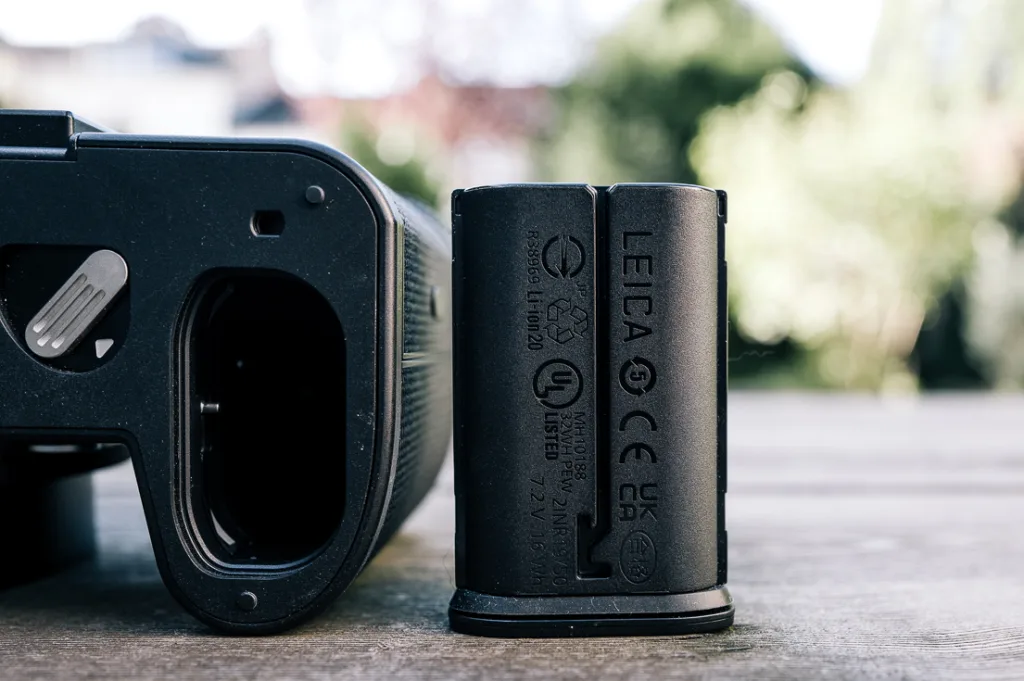
Video
To be honest, I have no idea. I didn’t try out any of the video functions of the SL3 during my few weeks with it. On paper, it sounds very decent. If this is important to you, you should find out more about it from elsewhere – especially about the AF and the rolling shutter effect in video.
Pros and cons
What I like
- The superior build quality and sturdiness
- The outstanding sensor (image quality!)
- The great EVF (except some minor points)
- The clean and logical menu system
- The overall UX (ergonomics)
- The Leica FOTOS App
What I don’t like
- Size and weight (especially with most lenses)
- Very noticeable rolling shutter effect with electronic shutter
Some points for improving
- Autofocus could be improved in some aspects
- Battery life could be improved
- Leica and Adobe should cooperate on implementing the Leica Looks into Lightroom (for DNGs)
Some thoughts about (these two) SL lenses
For me personally, the size and weight of most SL lenses are a real showstopper. The 50mm APO weighs 740 grams, which is almost as much as my entire Q3. The Leica SL3 and this lens together weigh about 1.5 kg and are really not to be overlooked. For photographers who use this on (commercial) shoots or in the studio, this is OK. On the street or in situations that are typical for me, it is much too heavy and much too big.
I don’t even want to talk about lenses like the Summilux-SL 50, the Vario-Elmarit-SL 24-90 or the 70-200 here – those are real monsters. But to be clear: none of this is a Leica-specific problem. The premium lines of most manufacturers, be it Sony, Nikon, Canon or even the Sigma Art lenses, are the same. I have absolutely no use for lenses of this size. But that’s only me, others might have no problem with the size and weight or even appreciate it due to a better grip or whatever.
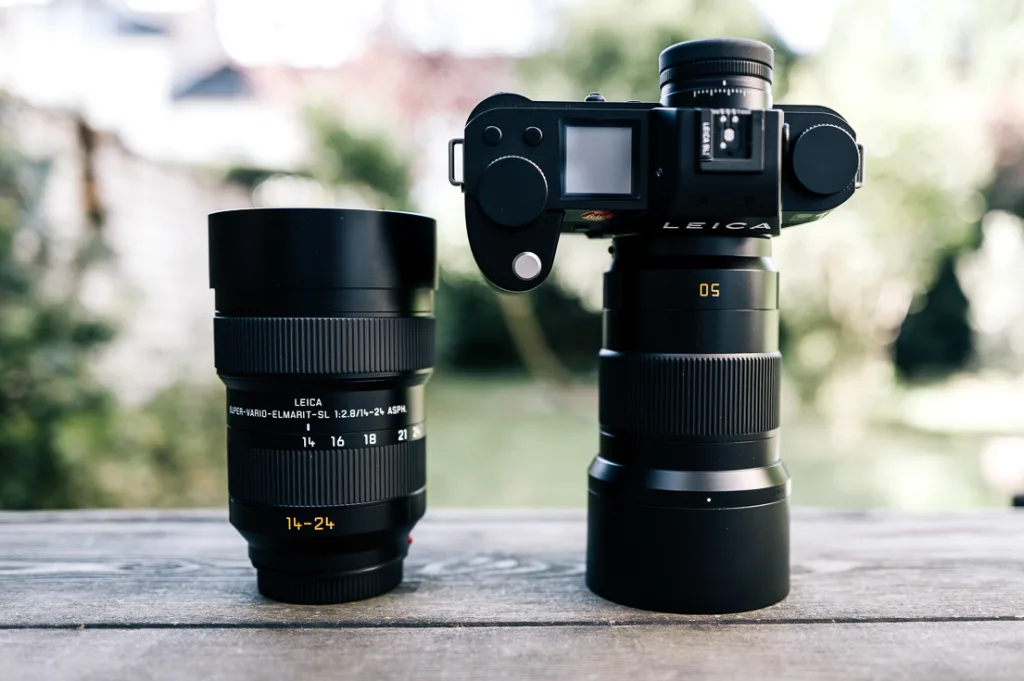
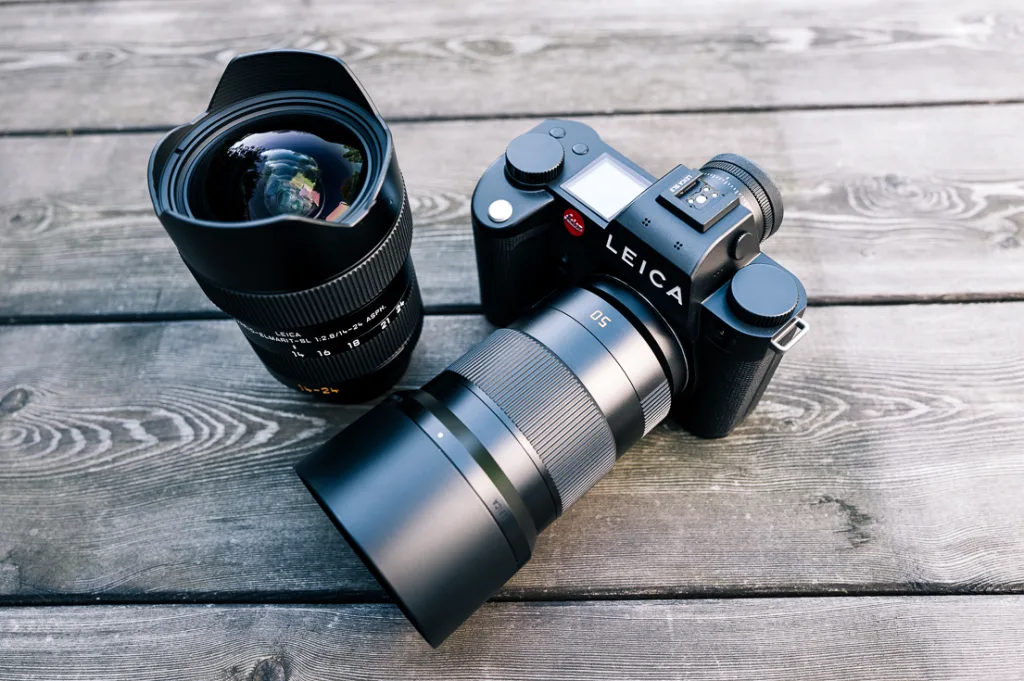
Fortunately for me, there are also Leica alternatives in some areas, such as the non-APO Summicrons 35 and 50. But I would probably even reach for the Sigma i-Series lenses, e.g. the Sigma 1:2/50mm.
The following is in no way a review of these lenses, just a brief opinion.
Vario-Elmarit-SL 1:2,8/14-24 ASPH.

I have found the 14-24 to be an excellent lens in the relatively short time I have been trying it out. It is fast, optically really convincing and especially great for reportage purposes in tight situations. I was particularly impressed by how well the flares were controlled by a lens with such a huge front lens.

Mechanically, like the other SL lenses, it is simply brutally stable. In relation to its focal length range and speed, it is still relatively small and light. At 855g, it is not much heavier than the APO-Summicron 50 and hardly much longer. Although of course it is not small in the true sense of the word – it can’t be.
Landscape photographers may be bothered by the fact that it does not have a front filter thread. Filters have to be inserted at the back, which is of course no real substitute. These photographers might prefer the 16-35 from the same company.
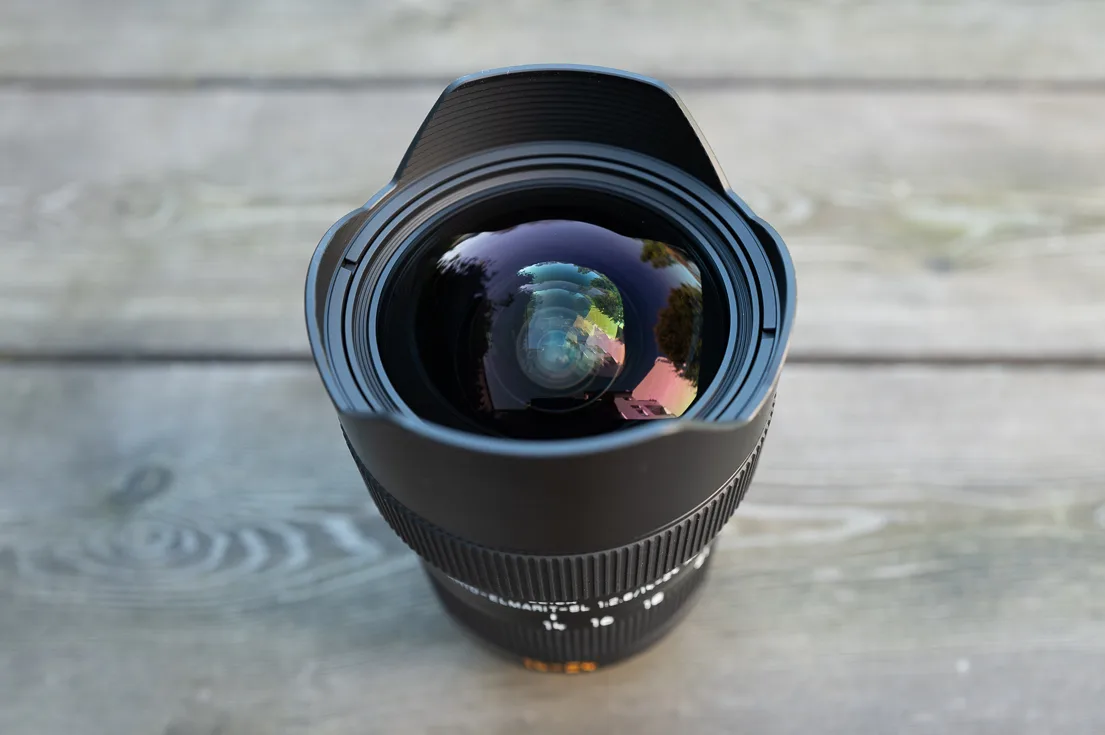
Yes, and then of course there’s the elephant in the room. It is obviously (optically) identical to the Sigma Art 14-24mm F2.8 DG DN – which costs just about half as much. This is one (of the good) consequences of the co-operation with Sigma in the L-Mount Alliance. The decision for or against the Leica version – with perhaps smaller manufacturing tolerances and a different body – is then up to you. It’s always good that there are alternatives.
APO-Summicron-SL 1:2/50 ASPH.
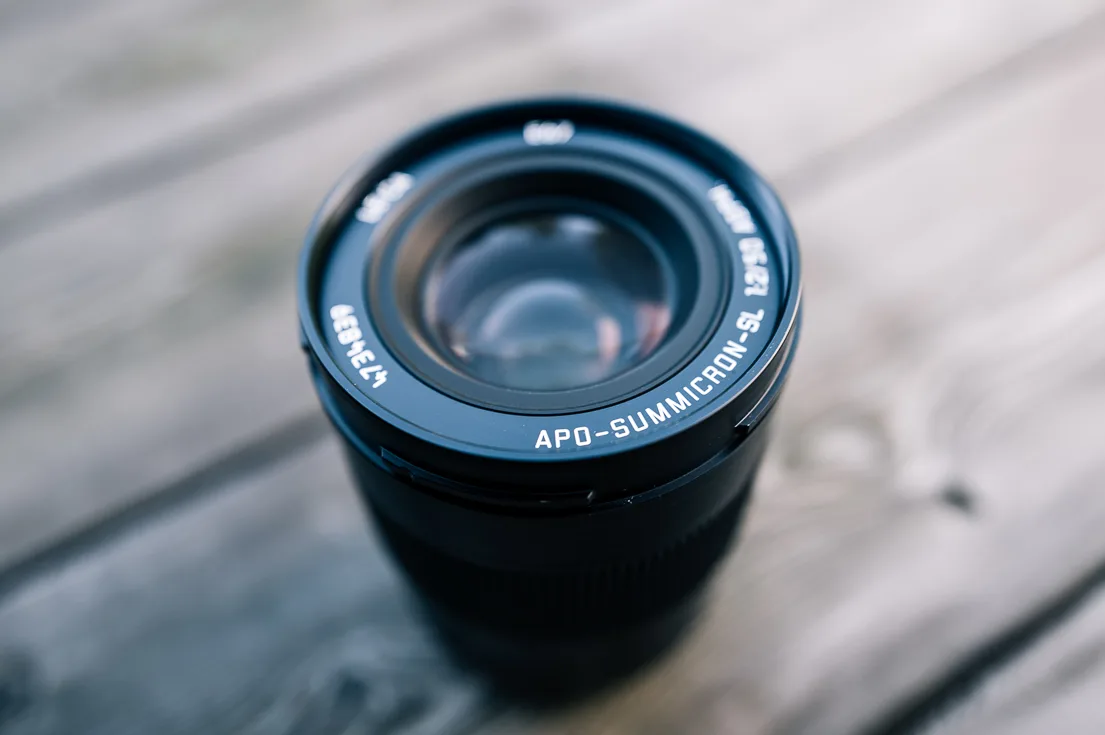
Yes, the image quality out of this lens is absolutely outstanding. I did not photograph any test charts or bricks but looked at the images. This lens is always tack-sharp, whether wide open or stopped down. Images are very rich in (micro)contrast and flare is as well controlled as chromatic aberrations are. The rendering is generally very smooth and beautiful – also in the out-of-focus areas (great bokeh!).

I can’t see a single possible weak point regarding the optical performance of this super-lens – unless you want a vintage look that is full of special character and imperfections. I don’t think that the APO-Summicron-M can be ‘better’; at most, it’s ‘different’. Optically, I have never had a better lens in my hands. Period!
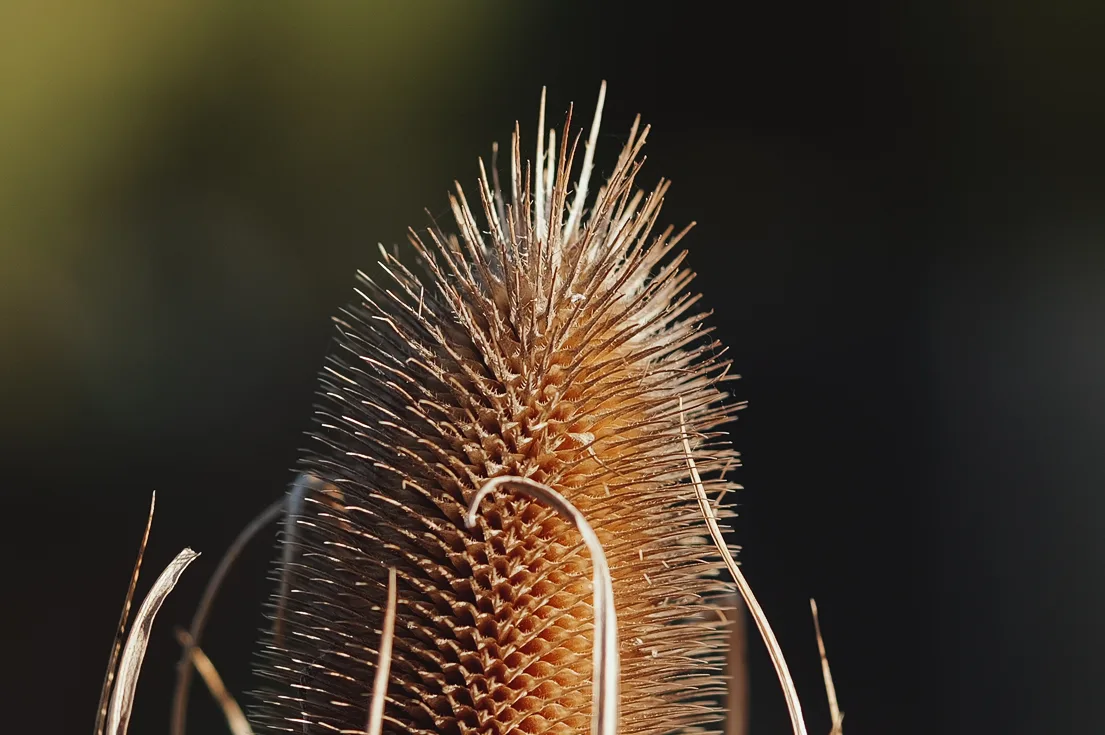
The autofocus is not lightning fast but is reasonable given the amount of glass it contains. Mechanically, it’s pretty much a tank. Extremely robust, full metal body, very high-quality – and very heavy. Which brings us back to my personal problem I have mentioned above. As good as it is, it’s not for me. It’s too big and too heavy for my taste.




Conclusions
Some general thoughts
As mentioned at the beginning of the post, the SL(3) is the only way to use a mirrorless Leica system camera. Leica is not a huge company that could bring out several product lines at the same time – and perhaps doesn’t even want to. It is of course possible that we will see a Leica SL3-S over time – but I wouldn’t expect much more.
Is that a bad thing or possibly a deal breaker? Certainly not for me. Personally, I would be very comfortable using the SL3 as a system camera and a Q3 as an everyday and street camera. Others will have different needs and therefore see this differently. And I know quite a few people who use another system like Sony in addition to a Leica (Q or M) – mostly as the pure (hybrid) workhorses. So, it’s obviously possible, but I wouldn’t want it.
To cut a long story short: Especially if you spend a lot of money on a Leica, you should and hopefully will know for yourself whether it makes sense for you.
Verdict
I think the title of this post is quite apt. The Leica SL3 is no beast. It is not a hyper-fast image machine and it is no supercomputer with a lens bayonet. And that’s a good thing! It is a camera, a beautiful camera and a camera for the beautiful. It’s a camera for photographers who value the highest image quality. There, it’s maybe kind of a beast. And it’s a camera for those who are looking for a tool that is intuitive to use and does not overwhelm you with every last function and menu item.
Before anyone gets the wrong idea, the SL3 is anything but outdated or old-fashioned. It is a modern, very powerful and, in many respects, excellent digital camera. It is just perhaps not always at the cutting edge of technological progress. But that is not what it is supposed to be.
I think it has its particular strengths in more conceptual shoots, in reportage situations, in landscape photography – at least if you are not put off by the size and weight. But other systems in this class are no smaller – not to mention medium format. You get what you pay for, and you have to carry what you think you need.
Highly recommended (with the aforementioned restrictions)
What will I personally do?
Will I buy an SL3?
No, or at least not right now. This is not because of the camera itself, but because I don’t want and I don’t need a system camera in addition to my Leica Q3 at the moment.
Would I buy an SL3?
Sure, if I needed a system camera, I would definitely do it. I don’t see any need for an extremely fast or extremely hybrid camera (like a Canon R5, Sony A9III, etc.) for myself personally in the future either. But I would see great advantages in the workflow (same sensor, colour science, etc. as the Q3) with the Leica SL3. And the camera suits me much better in terms of its philosophy and user experience than the – admittedly very impressive – ‘camera computers’ mentioned above.
To be honest, as things stand today, I would almost rather get the new Leica Q3 43 in addition to my Q3 to have two of the same cameras with what are probably the only focal lengths I ever need. But I’m still resisting this reflex and sticking to my self-imposed one-camera, one-lens philosophy for the time being. 😉
There is always light somewhere – go out and shoot!
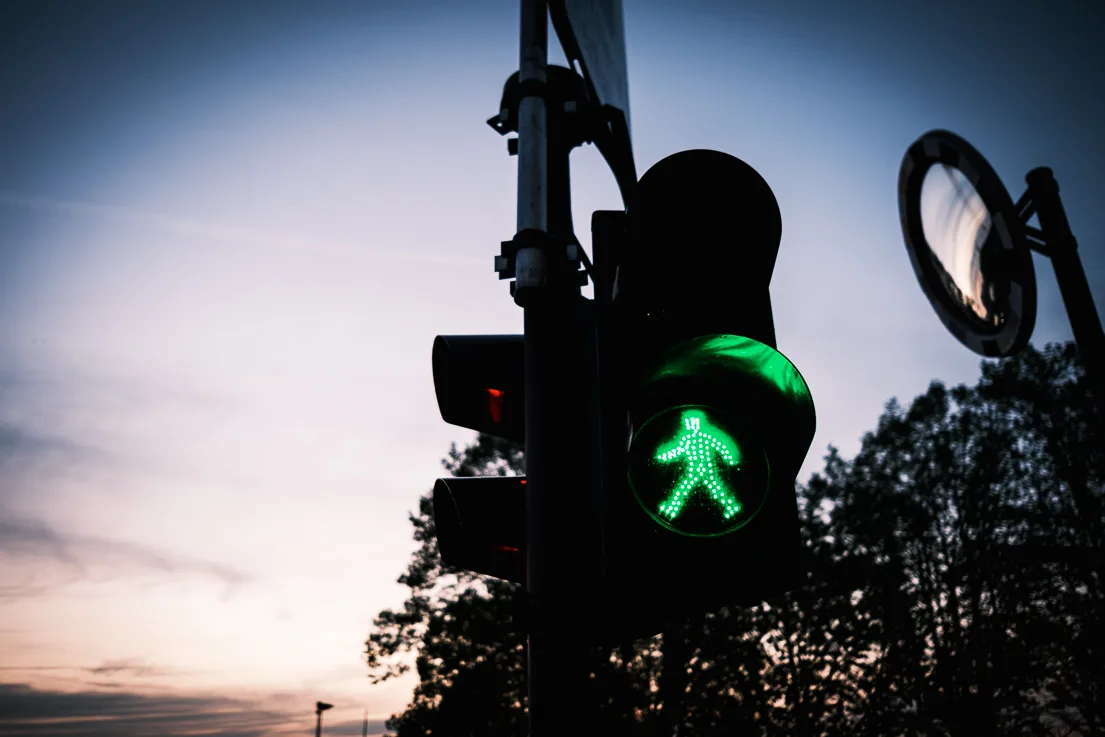
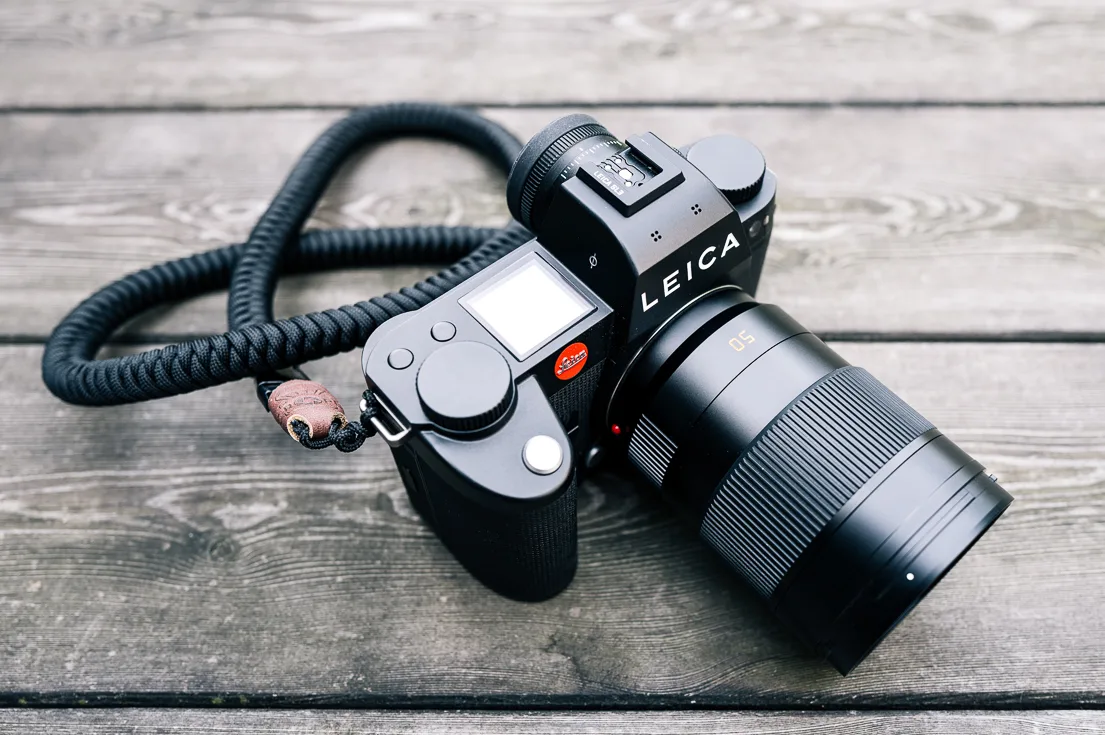
Hi Peter,
Do I sense some ‘M’ appearing in the 11th month?
Best wishes and have a nice day & shoot!
Jan
Hi Jan,
haha… even though I wrote that things often turn out differently than you think, the answer is no. I don’t see myself shooting with a M in the near future, maybe never. But who knows? 😉
I also don’t know if I’ll ever get one in my hands for a review – and I wouldn’t prioritise that at the moment. The SL3 thing wasn’t really planned either, and I had to free up a lot of time that I didn’t really have… 😉
Best regards in return,
Peter
“It is a beautiful camera for the beautiful”. Man kann es wohl nicht besser zusammenfassen. Oder, um zynisch zu werden, ein schicker Tank mit dem man auch Bilder in chicen Farben machen kann. Der Autor hat sich wirklich ehrliche Mühe gegeben, das Ding ehrlich zu beschreiben, und dabei muss man zu dem Schluss kommen, dass die SL3 eben wirklich eine Kamera ist, für Leute, die gern zeigen wollen, eine Leca zu besitzen. wohl mit Zielregion Fernost! Vom Design her, auch das wird ja eingeräumt, eine Kamera gestylt um des Designs willen. Was hier als positiv herausgestellt wird, etwa das Schulter-Display, ist bei anderen Herstellern seit fast Jahrzehnten Standard. Die hübschen Icons und die Beschriftung, so könnte man meinen, deuten darauf hin, dass der Mensch, der sie besitzt, auch noch spielen kann. Design a la Colani aus den 1970ern??? der fantastische Sensor, der wie eine billige Sony A7 gute Bilder macht? Der AF immerhin langsam aber ausreichend? Wurde das Gehäuse von Panasonic hergestellt. “von den Details ähnelt sie meiner älteren Lumix”, sagte mir heute ein Freund. Abgesehen von den 60 Megapixeln also eine Kamera bestenfalls von gestern. Insofern ist diese Beurteilung ganz ehrlich ein meisterwerk des Verrisses in wunderbare Worte gefasst. Wer Augen hat, zu lesen, erkennt das schnell. Danke für den vergnüglichen Lesestoff!
Ach Christian,
das wird ja langsam zu einem richtigen Ritual – und ich fange an, Spaß daran zu entwickeln. Nun sogar mit einem ganz neuen Kapitel. Dem Kommentator gelingt es hier sogar eindrucksvoll, den Text des Autors so zu lesen und zu interpretieren, wie dieser ihn gar nicht gemeint und geschrieben hat. Als Höhepunkt sogar mit einer interessanten (und zugegeben durchaus cleveren) Lesart und Übersetzung des obigen Zitates. Kann man so machen – muss man aber nicht. Vielen Dank zurück für den vergnüglichen Lesestoff. Was soll ich sagen? Wer seine Augen stets auf das Negative legt, wird sicher auch immer viel Negatives entdecken. Vielleicht mag der Autor dieses Kommentars mal bei einem Kaffee darüber nachdenken… wenn er mag.
Vergnügliche Grüße
Peter
Toller Bericht.
Ich habe mir zu meiner Q2 (die ich liebe) eine gebrauchte SL2 gekauft. Da ich ebenfalls keien großen Objektive mag, kam das Sigma 28-70 und das Panasonic 85 1.8 dazu. Für Paare und Hochzeiten.
Ich komme von einer GFX50S II und ich könnte die SL2 den ganzen Tag anfassen und streicheln so gut ist sie.
Ich hoffe noch auf weitere kleine Objektive von Panasonic die mit der neuen S9 erscheinen (18-40).
Hallo Thomas,
vielen Dank fürs Lesen und Deinen Kommentar. Eine interessierte Rückfrage meinerseits: Warum nicht die Sigma i-Series? Ja, OK, nominell nicht wetterfest, aber mich würde das eher nicht so arg ängstigen. Aber nach allem, was ich so mitbekomme, sind die sehr gut. Und wirklich sehr klein… für mich wäre das 50er f2.0 gesetzt, wenn ich eine SL3 holen würde. Denke ich zumindest…
VG Peter